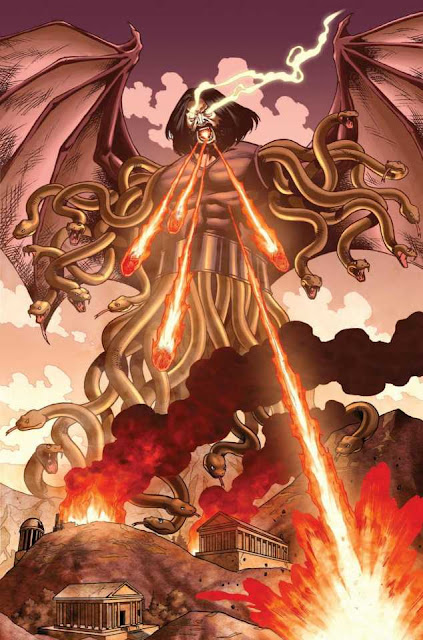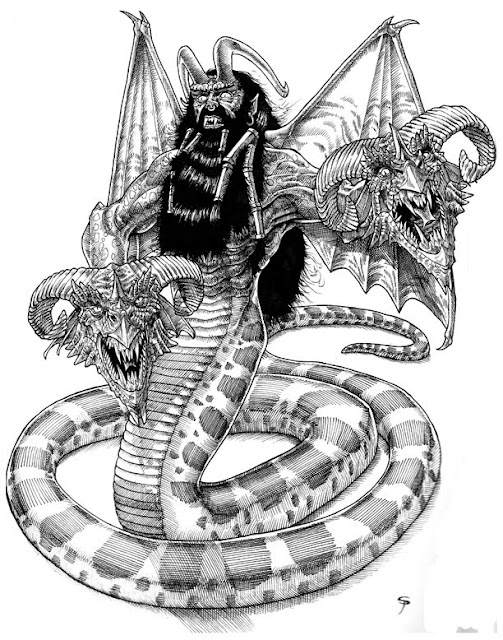IN revenge for the destruction of the giants, Mother Earth lay with Tartarus, and presently in the Corycian Cave of Cilicia brought forth her youngest child, Typhon: the largest monster ever born. From the thighs downward he was nothing but coiled serpents, and his arms which, when he spread them out, reached a hundred leagues in either direction, had countless serpents’ heads instead of hands. His brutish ass-head touched the stars, his vast wings darkened the sun, fire flashed from his eyes, and flaming rocks hurtled from his mouth. When he came rushing towards Olympus, the gods fled in terror to Egypt, where they disguised themselves as animals: Zeus becoming a ram; Apollo-a crow; Dionysus-a goat; Hera-a white cow; Artemis-a cat; Aphrodite-a fish; Ares-a boar; Hermes-an ibis, and so on.
c. The news of Zeus’s defeat spread dismay among the gods, but Hermes and Pan went secretly to the cave, where Pan frightened Delphyne with a sudden horrible shout, while Hermes skillfully abstracted the sinews and replaced them on Zeus’s limbs.
d. But some say that it was Cadmus who wheedled the sinews from Delphyne, saying that he needed them for lyre-strings on which to play her delightful music; and Apollo who shot her dead.
e. Zeus returned to Olympus and, mounted upon a chariot drawn by winged horses, once more pursued Typhon with thunderbolts. Typhon had gone to Mount Nysa, where the Three Fates offered him ephemeral fruits, pretending that these would restore his vigour though, in reality, they doomed him to certain death. He reached Mount Haemus in Thrace and, picking up whole mountains, hurled them at Zeus, who interposed his thunderbolts, so that they rebounded on the monster, wounding him frightfully. The streams of Typhon’s blood gave Mount Haemus its name. He fled towards Sicily, where Zeus ended the running fight by hurling Mount Aetna upon him, and fire belches from its cone to this day.
1. ‘Corycian’, said to mean ‘of the leather sack’, may record the ancient custom of confining winds in bags, followed by Aeolus, and preserved by mediaeval witches. In the other Corycian Cave, at Delphi, Delphyne’s serpent-mate was called Python, not Typhon. Python (‘serpent’) personified the destructive North Wind-winds were habitually depicted with serpent tails-which whirls down on Syria from Mount Casius, and on Greece from Mount Haemus. Typhon, on the other hand, means ‘stupefying smoke’, and his appearance describes a volcanic eruption; hence Zeus was said to have buried him at last under Mount Aetna. But the name Typhon also meant the burning Sirocco from the Southern Desert, a cause of havoc in Libya and Greece, which carries a volcanic smell and was pictured by the Egyptians as a desert ass. The god Set, whose breath Typhon was said to be, maimed Osiris in much the same way as Python maimed Zeus, but both were finally overcome; and the parallel has confused Python with Typhon.
2. This divine flight into Egypt, as Lucian observes (On Sacrifices), was invented to account for the Egyptian worship of gods in animal form-Zeus-Ammon as ram, Hermes- Thoth as ibis or crane, Hera-Isis as cow, Artemis-Pasht as cat, and so on; but it may also refer historically to a frightened exodus of priests and priestesses from the Aegean Archipelago, when a volcanic eruption engulfed half of the large island of Thera, shortly before 2000 BC. Cats were not domesticated in Classical Greece. A further source of this legend seems to be the Babylonian Creation Epic, the Enuma Elish, according to which, in Damascius’s earlier version, the goddess Tiamat, her consort’ Apsu, and their son Mummi (‘confusion’), let loose Kingu and a horde of other monsters against the newly-born trinity of gods: Ea, Anu, and Bel. A panic flight follows; but presently Bel rallies his brothers, takes command, and defeats Tiamat’s forces, crushing her skull with a club and slicing her in two ‘like a fiat-fish’.
3. The myth of Zeus, Delphyne, and the bear-skin records Zeus’s humiliation at the hands of the Great Goddess, worshipped as a She-bear, whose chief oracle was at Delphi; the historical occasion is unknown, but the Cadmeians of Boeotia seem to have been concerned with preserving the Zeus cult. Typhon’s ‘ephemeral fruits’, given him by the Three Fates, appear to be the usual death-apples. In a proto-Hittite version of the myth the serpent Illyunka overcomes the Storm-god and takes away his eyes and heart, which he recovers by stratagem. The Divine Council then call on the goddess Inara to exert vengeance. Illyunka, invited by her to a feast, eats until gorged; when upon she binds him with a cord and he is despatched by the Storm-god.
4. Mount Casius (now Jebel-el-Akra) is the Mount Hazzi which figures in the Hittite story of Ullikummi the stone giant, who grew at an enormous rate, and was ordered by his father Kumarbi to destroy the seventy gods of Heaven. The Storm-god, the Sun-god, the Goddess of Beauty and all their fellow-deities failed to kill Ullikummi, until Ea the God of Wisdom, using the knife that originally severed Heaven from Earth, cut off the monster’s feet and sent it crashing into the sea. Elements of this story occur in the myth of Typhon, and also in that of the Aloeids who grew at the same rate and used mountains as a ladder to Heaven. The Cadmeians are likely to have brought these legends into Greece from Asia Minor.


Comments
Post a Comment